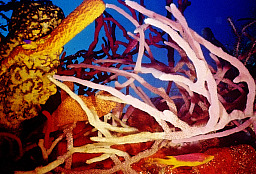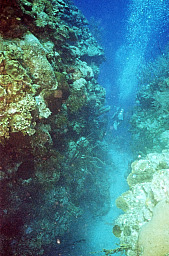Lighthouse Reef Dive Sites
Tuesday, May 25, 2004
017-11.700 N087-35.940 W
Ahoy from Lighthouse Reef, Belize!
 We're about to
depart from this wonderful place and head to Roatan, Honduras. Before we go I
wanted to do a summary of the dive locations here. This is truly a wonderful
place to dive. I've dove in a LOT of locations around the Caribbean, Florida and
Hawaii (note how the US North East didn't even make this list :-) and this area
is at the top of my list.
We're about to
depart from this wonderful place and head to Roatan, Honduras. Before we go I
wanted to do a summary of the dive locations here. This is truly a wonderful
place to dive. I've dove in a LOT of locations around the Caribbean, Florida and
Hawaii (note how the US North East didn't even make this list :-) and this area
is at the top of my list.
If you like wall diving, this place is for you. The wall around the atoll rises up from thousands of feet to about 40 feet in the blink of an eye. And quite often the visibility is hundreds of feet. I absolutely love gliding over the top of the reef and looking straight down hundreds of feet. The top of the reef is typically at 30 to 45 feet and contains an amazing variety of large and small fish in abundant quantities. The coral is also very alive and extremely diverse. On top of that there's a plethora of hard and soft sponges. I'm constantly pulling our Reef Fish/Coral/Creature books out to identify species new to us.
 Lately I've had several
dives where I was in a Zen-like mode and everything was perfect. The light was
perfect, no current, the visibility went on forever, I felt like I had grown
gills and the gauge on my air tank crept incredibly slowly towards zero and
thousands of fish were out to play making you feel like you were in the most
spectacular aquarium you've ever seen. On a recent dive we saw a huge Hawks Bill
Turtle whose neck was probably a foot in diameter and whose flipper span was
better than 6 feet. While very rare, we've also been circled by 10' Bull sharks,
which certainly gets your blood pumping! There are large schools of big fish
that allow you to swim with them and the tops of coral heads are covered with
halos of tiny fish.
Lately I've had several
dives where I was in a Zen-like mode and everything was perfect. The light was
perfect, no current, the visibility went on forever, I felt like I had grown
gills and the gauge on my air tank crept incredibly slowly towards zero and
thousands of fish were out to play making you feel like you were in the most
spectacular aquarium you've ever seen. On a recent dive we saw a huge Hawks Bill
Turtle whose neck was probably a foot in diameter and whose flipper span was
better than 6 feet. While very rare, we've also been circled by 10' Bull sharks,
which certainly gets your blood pumping! There are large schools of big fish
that allow you to swim with them and the tops of coral heads are covered with
halos of tiny fish.
The Lighthouse Reef atoll is 23 miles long by 5 miles wide at its widest and contains 6 islands or cays. The area that I'm going to focus on only consists of Long Cay, which is about 2 miles long and Half Moon Cay, which is only 1/2 of a mile long. As you can tell, there's a lot of unexplored (at least by me) reef out there! We've spent about 5 months at Lighthouse over the past 2 years, and we typically dove 1-2 times per day which has given us an excellent opportunity to explore the reef in a variety of conditions.
 The majority of our time
has been spent at Long Cay. There are 2 anchorages here: The west anchorage
provides protection from the majority of winds and has good holding; And the
east anchorage provides good protection from the north but is a long way from
any dive balls. There are 8 dive balls located along the western edge of the
reef starting mid-island and going north. The most southerly of these is the
entrance over the reef. These have been installed and are maintained by the
live-aboard dive boat companies. The moorings are very robust and can easily
handle any size yacht. There's no problem tying up to a dive ball for an hour or
so while diving, but don't use these as a long term day mooring as the
live-aboard dive boats move between them frequently.
The majority of our time
has been spent at Long Cay. There are 2 anchorages here: The west anchorage
provides protection from the majority of winds and has good holding; And the
east anchorage provides good protection from the north but is a long way from
any dive balls. There are 8 dive balls located along the western edge of the
reef starting mid-island and going north. The most southerly of these is the
entrance over the reef. These have been installed and are maintained by the
live-aboard dive boat companies. The moorings are very robust and can easily
handle any size yacht. There's no problem tying up to a dive ball for an hour or
so while diving, but don't use these as a long term day mooring as the
live-aboard dive boats move between them frequently.
The dive balls mentioned above are named (S-N) Long Cay Ridge, Dos Coco, Que Brada, Long Cay Wall, Cathedral, Silver Caves, Aquarium and Painted Wall. The sites at the northern end are shallower at the top and typically have an astounding number of fish near the surface. At the Aquarium you'll be greeted by schools of Yellow Tail Snappers, Chubs and Sargent Majors who like to be fed. The dive sites at the southern end have more coral canyons and channels to swim through. The top of the reef is at about 45-50 feet at the northern end and 25-35 feet at the southern end. The reef gets very shallow on the northern end which is great for snorkeling. Our first dive leg is typically at 70 feet (60 to 85') where the bigger fish tend to hang out. At 1500 lbs we turn around and swim the top of the reef enjoying the bright sunlight, littler fish and lovely corals and sponges.
 The reef on the east side
of Long Cay is a drying reef and is impossible to get across except by going
outside and around. As a result we've never dove the balls out there. There are
supposed to be 4 balls, named Inspiration, Two of a Kind, Eternity and Came
lion.
The reef on the east side
of Long Cay is a drying reef and is impossible to get across except by going
outside and around. As a result we've never dove the balls out there. There are
supposed to be 4 balls, named Inspiration, Two of a Kind, Eternity and Came
lion.
We've also been told that there are 3 balls around Hat Cay, which is to the south of Long Cay. We found one ball north of Hat Cay and had a very nice dive with lots of canyons. Note that we've also just dropped an anchor in sand patches and dove between Hat Cay and the southern most mooring ball and have had great dives in areas not frequented by anyone.
 Half Moon Cay has a
stunning anchorage with rich blue water atop of white sand. It's one of my
favorite anchorages. The biggest problem is that there's a ton of salt spray in
the air from the waves crashing over the reef and the boat ends up getting
coated with salt. The area around Half Moon Cay is an underwater park delineated
by posts in the water. No fishing or taking of conch is allowed within the park.
There are 5 dive balls on the south side of Half Moon Cay and they're named
(W-E) Paradise Channel, Catain Wall, Tarpon Caves, Dolphin Pass and Lighthouse
Wall. Most of these have a wide sand channel running parallel to the reef and
then channels running to the reef. At one point they tried to erect underwater
signs with information about the biology, but most of these are disintegrated
and are unreadable. On occasion we've experienced strong currents, but most of
the time it's very light.
Half Moon Cay has a
stunning anchorage with rich blue water atop of white sand. It's one of my
favorite anchorages. The biggest problem is that there's a ton of salt spray in
the air from the waves crashing over the reef and the boat ends up getting
coated with salt. The area around Half Moon Cay is an underwater park delineated
by posts in the water. No fishing or taking of conch is allowed within the park.
There are 5 dive balls on the south side of Half Moon Cay and they're named
(W-E) Paradise Channel, Catain Wall, Tarpon Caves, Dolphin Pass and Lighthouse
Wall. Most of these have a wide sand channel running parallel to the reef and
then channels running to the reef. At one point they tried to erect underwater
signs with information about the biology, but most of these are disintegrated
and are unreadable. On occasion we've experienced strong currents, but most of
the time it's very light.
There's a resort that's being built on the northern end of Long Cay. It's clearly had a lot of financial difficulty as there appear to have been 3 owners to date and it hasn't opened yet. The hotel, restaurant, bar and a medical clinic has been built and pretty well furnished. The rooms are very sparse, and some have great views. The medical clinic has a hyperbaric chamber in it, but it's not functional at this time. I assume that you'll be able to get tanks filled at the resort once it's running. Until then you can have tanks filled by the live-aboard dive boats for $5 US per tank. I'm not happy at all to see Long Cay being developed. Maybe they will be able to cohabitate with the reef, but I'm afraid that this pristine area will be permanently harmed by this development. My suggestion is to see it now while it's in the condition that it is.
-- Geoff & Sue
Log ID: 491
Photos/Video:
To receive these logs via e-mail, please subscribe to the mailing list or you can follow us on FaceBook by clicking: